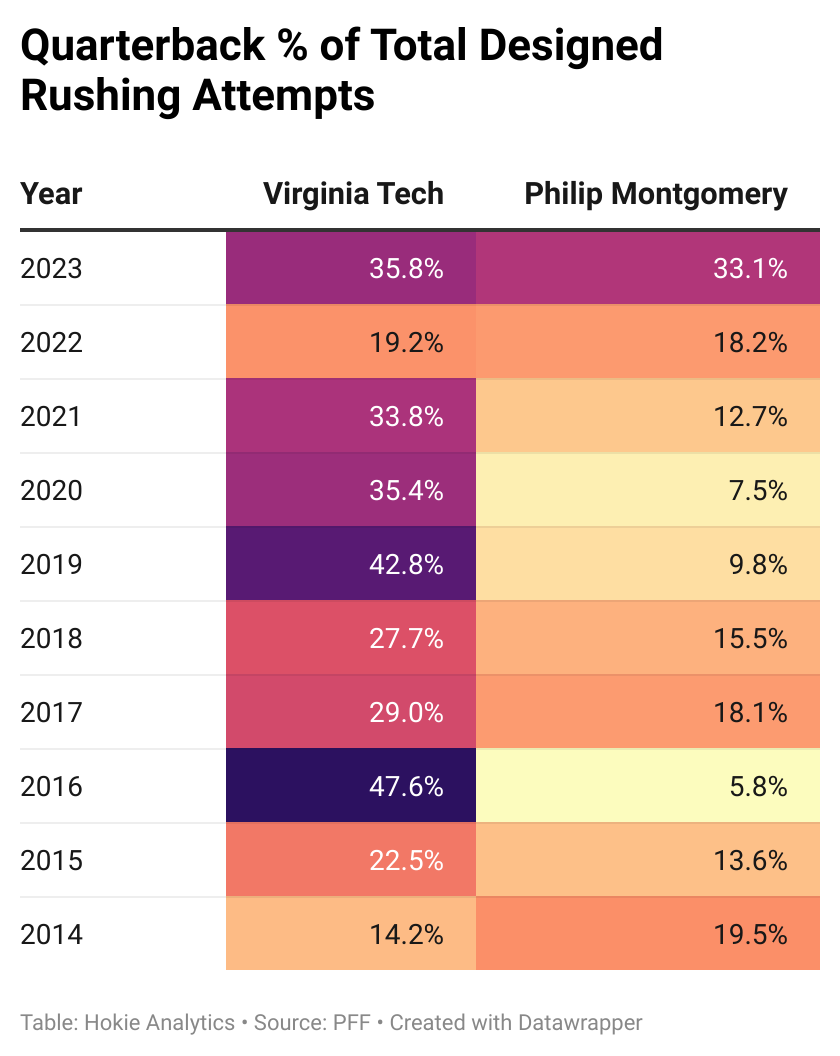I’ve been thinking all offseason about the importance of keeping Kyron Drones healthy this year.
Over the weekend, I took a step back to check my priors.
Does it even matter whether or not the Hokies keep their starting quarterback healthy?
In the aggregate, the answer is a surprising, “Not much!”
Here is the breakdown of average regular season wins by starting quarterback health status dating back to 2014:
Starting QB misses 0 games due to injury: 6.4 wins/year
Starting QB misses >1 game due to injury: 6.1 wins/year
Those numbers are biased a bit by the horrendous 2022 team. If we filter that year out, the average wins/year when the Virginia Tech QB remains healthy increases to…6.7 games.
Surprisingly, there really is not much difference, on average, even if we remove the major outlier.
It is pretty clear, though, that another year of 6-6 will have the Hokies in the market for a new head coach, not to mention a new athletic director.
That means we need to look at the likelihood of winning enough games to keep the current regime in power.
Picking a number here is easy. Since 2014, the Hokies have won 6 games seven times and 8 or more games three times, but they have not once landed on 7 wins in the regular season.
As such, we’ll set 8 wins as the minimum Pry needs in order to keep his job.
With that as the dividing line, we do see a discernable difference in starting quarterback health.
Win 8 or more games: 2 out of 3 years (67%) the QB did not miss a start (both were 9-win seasons)
Win 6 games of less: 2 out of 8 years (25%) the QB did not miss a start (3- and 6-win seasons)
In that context, Pry’s job does appear to depend on the team’s ability to keep Kyron Drones healthy and in the lineup.
How can the Hokies do that, especially with so many new faces along the offensive line?
Simple - limit the designed QB runs.
Scot Loeffler, Brad Cornelsen, and Tyler Bowen
In years when the starting quarterback does not miss any games due to injury, an average of 25.4% of designed Virginia Tech carries (this metric excludes scrambles) were by quarterbacks.
In years when the starting quarterback misses at least one game due to injury, 31.1% of designed carries were by quarterbacks.
The delta of 5.7 percentage points may not appear compelling on its face, but once again an outlier is skewing the data.
In 2016, Jerod Evans started every game, despite leading the team (by a wide margin) in designed carries. In fact, quarterbacks were responsible for 47.6% of all designed carries that year.
The 47.6% mark in 2016 is the highest out of the years examined, comfortably surpassing 2019, in which 42.8% of designed carries were by quarterbacks.
And the 2019 figure is skewed by third-string QB Quincy Patterson carrying the ball so much in the North Carolina and Notre Dame games.
Excluding the anomalous years, the disparity in the percentage of designed carries allotted to Hokie quarterbacks increases significantly:
Healthy QB years: 20.7% of designed carries
Injured QB years: 30.0% of designed carries
In the last two seasons, Hokie quarterback carries comprised 35.8% and 33.0% of all designed carries.
All this begs the question: What is new offensive coordinator Phillip Montgomery’s track record on spreading carries around?
Phillip Montgomery
Phillip Montgomery’s recent college offenses do not utilize the quarterback much in the run game.
From 2014-23, in only one year was the quarterback position responsible for more than 30% of designed carries.
That was the most recent year, 2023, when Montgomery was at Auburn and QB carries comprised 33.1% of the total.
Even that does not tell the entire story. In 2023, Payton Thorne, Auburn’s starting quarterback, had at least 10 designed runs in only 1 of the team’s first 6 games. In the second half of the season, when Hugh Freeze took back some of the play-calling duties, Thorne had double-digit designed carries in 5 out of 6 games.
At Baylor, in 2014, designed QB runs comprised 19.5% of the total.
In between, during his eight years as Tulsa’s head coach, Montgomery also called the offensive plays.
In all eight seasons, quarterback carries made up less than 20% of the total carries. In three of those seasons, QB designed runs comprised less than 10% of total runs.
Will the Montgomery hire work out?
If nothing else, Montgomery’s play-calling preferences are a good fit for what ails Hokie quarterbacks.

The Hokies appear to have a stable of good running backs and plenty of up-and-comers at wide receiver.
The two big remaining questions are:
Can Tech win with Kyron Drones operating as a drop-back passer?
Can the offensive line open up holes without the quarterback being a major threat to run the ball?
Neither Drones nor the offensive line seems ideally suited to the task at hand, but then, that was the case for plenty of Frank Beamer’s 10-win teams.
It’s amazing how many warts elite tailback play can cover.
And if the running backs aren’t elite, is there any hope for 2025?
Well, entering the 2004 season, the offensive line was taking a step back, Bryan Randall was a dual-threat quarterback set to run a pro(-ish) style offense, and Kevin Jones had just left for the NFL.
The line ended up being pretty average, Randall blossomed into the ACC Offensive Player of the Year, and together they combined with running backs Cedric Humes, Mike Imoh, and Justin Hamilton to provide just enough offense, in combination with an elite defense, to win 10 games and finish in the Top 10 in the country.
With that in mind, one needn’t squint to see 8 Hokie wins in 12 regular season games in 2025.
The pieces are there.
This team has a chance.



